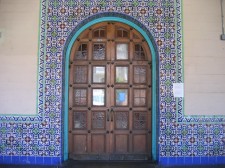
Berkeley, California Rose Garden
The garden, featuring 1,500 varieties of roses, was one of the first of the New Deal’s Civil Works Progress projects. Conceived in 1933, it was dedicated for public use in 1937.
Photo Credit: Susan Ives
I had to think hard when a reporter recently asked me what most surprised me about what I’ve learned about the New Deal. After a pause, I replied “The importance of aesthetics.” My response was primed by the first sentence of a list of goals set forth by the National Resources Planning Board [NPRB] for what the Roosevelt Administration sought to achieve after the war:
“The fullest possible development of the human personality, in relation to the common good, in a framework of freedoms and rights, of justice, liberty, equality, and the consent of the governed.”
I marveled at how alien such a high and holistic aspiration seemed not only in the present but in all the administrations of my lifetime. It was especially so in light of the time it was written— January, 1943 at the nadir of the Second World War when Americans were still under food rationing. But, in fact, it succinctly summarizes much of what the New Deal set out to accomplish.

Central Court, Main Library, Toledo, Ohio
This public library was constructed in 1939 with the aid of Public Works Administration (PWA) and the Works Progress Administration (WPA). A multi-color glass mosaic crowns the lobby.
Photo Credit: Evan Kalish
Although Franklin and Eleanor Roosevelt had all of the advantages that inherited wealth and status gave them—spending three months on the Grand Tour of Europe for their honeymoon, for example—they both came to believe that access to beauty should not be the exclusive prerogative of their own class. In 1941, in his dedication of the National Gallery of Art in Washington, D.C., President Roosevelt declared that great works of art such as those in the Gallery belong to all men everywhere, but that the government furthermore had a duty to create new art and take it to where there had been none before.
The WPA’s Federal Music, Theatre, Writing, and Art Projects and the Treasury Section of Fine Arts did just that, so that Roosevelt could deftly leap in his speech from Andrew Mellon’s gift of Old Masters in the Gallery to what FDR felt all Americans were entitled to: “Recently… they have seen in their own towns, in their own villages and schoolhouses and post offices, in the backrooms of shops and stores, pictures painted by their sons, their neighbors, people they’ve known and lived beside and talked to.” Both FDR and Eleanor believed that access to beauty was essential for “the full development of the human personality” not only for healthy individuals, but also for a healthy democracy. Even in the absence—or obverse—of such goals at the federal level today, New Deal projects such as Central Park’s Conservatory Gardens, Mt Hood’s Timberline Lodge, and Denver’s Red Rock Amphitheatre have enabled millions to nourish their spirits just as the NPRB hoped they would in the midst of war.
From FDR’s speech at the National Gallery dedication:
“Great works of art belong to all men everywhere. Art was foreign to Americans, they were taught. Recently, they have discovered that they have a part. They have seen their own towns, in their own villages and schoolhouses and Post Offices, in the backrooms of shops and stores, pictures painted by their sons, their neighbors, people they’ve known and lived beside and talked to. They have seen across these last few years rooms full of painting and sculptures by Americans. Walls covered with the paintings by Americans. Some of it good, some of it not so good. But all of it native and human and eager and alive; all of it painted by their own kind in this country. And painted about things they know and look at often and have touched and loved.”
—Dedicated in conviction that the freedom of the human spirit shall go on too.


New Deal buildings could have served their purpose by being utilitarian. Instead, they honor the gifted men and woman who created them and the ordinary people who used them — and continue to use them. Thank you, Living New Deal, for reminding us!
Beauty can save us. It can certainly elevate us to nobler acts and ways of living together for the common good.
Wonderful thoughts. Thank you.